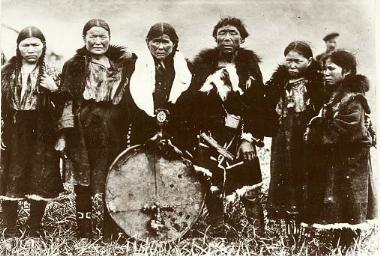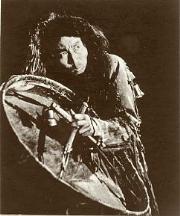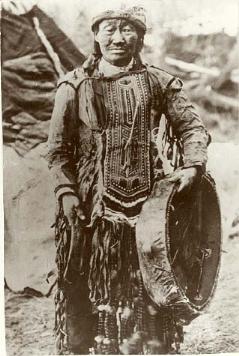
Karina Solovyova Russian Museum of Ethnography
Koryak group with a drum, 1915.

The baton was one of the major shamanic ritual artifacts for the Evenks, Sel'kups, Nenets, and Kets, and it had many symbolic functions. It was used as a striking instrument, and it also represented a special spirit helper of the shaman for the Evenks and Kets. It was also pogonyalka—the tool for driving the "reindeer" or the oar for the "boat," which according to the ideas of the Nenets, Nganasans, Ents, Evenks, and Sel'kups was represented by the drum. The Evenk word for baton, ghis, literally means "talking" or the "object for telling the future," and this emphasized another function. The Evenks used the baton to forecast the future regarding the offspring of the reindeer herd or the loss and the fate of people. The shaman threw the baton towards the interested person, and the future was determined by how it would fall. Some batons of Sel'kup shamans had a cavity with stones inside and were used as rattles instead of as drumsticks. The Sel'kups also used the baton to cure the sick. By touching the place of pain with the baton, the shaman extracted the cause of the disease (the evil spirit), or he or she placed the sought-after soul of the sick person on the end of the handle and then back into the person.
Yakut shaman with a drum, early 1900s.

Following a period of instruction, the young shaman received his or her first drum. Rarely were the drum and baton received at the same time. The base of the drum was made of a special wooden hoop and was oval or circular in shape. The hide from a wild reindeer or a moose was pulled over the hoop. The main tool of shamans, the drum enabled the shaman to call spirits by means of sounds. The drum was not only a musical instrument, but it was also symbolic of the universe. The World (upper, middle, and lower), Sun, Moon, and many cosmological elements were depicted on it. Among the cultures of the Evenks, Kets, Sel'kups, and Nenets, the drum was associated with the reindeer, the riding of which enabled the shaman to go on journeys. The drum was the main helper of the shaman and was the symbol of his or her strength. This is indicated by the ritual of animating the drum.
The new drum, the Sel'kups believed, had no powers, and it could not be used for religious rites, or kamlaniye, as it might break. Therefore, the ritual of initiation or animation was conducted so that the drum could come alive. In the spring, as birds arrived, a collective feast was organized where an old experienced shaman who had performed a journey to the country of his or her ancestors was invited. The Kets had a similar ritual.
According to the Evenks, all relatives of shamans were present at the drum initiation ceremony. The ritual of drum animation was conceived as a magical chase, the slaughter of the mythical beast, and its subsequent revival. The ritual ended with a meal during which people ate meat of a reindeer killed the day before. Afterwards, the drum was decorated with drawings, and pendants were attached on the internal portion and to the handle of the drum. The last step in the initiation of the drum was the singing of the shaman's song and the right of every relative to perform a circle dance with the drum that symbolized the joining and becoming a part of the powers of nature. This ritual activity was associated with the ideas of prosperity of the clan, life, success, and the fecundity of humans and animals. The internal part of the drum was the place where helper spirits gathered. During kamlaniye the shaman called for his helper spirit and protectors and went on journeys with their help. The Sel'kups, Kets, and Evenks attached protector spirits made from metal, wood, and leather to the drum.

Shaman Khorolkan of the Kambaghir tribe of the Evenk, first quarter of the nineteenth century. No. F42-11.
After the drum and baton were received by shamans of the Evenks, Sel'kups, and Kets, relatives manufactured an apron to which pendants representing helper spirits were gradually attached according to the shaman's instructions. These were "fed" with ritual foods, such as blood, and asked for advice during kamlaniye. As the shaman became more powerful, the number of pendants on the apron and then on the shaman's costume increased. A caftan, an ankle-length coat-like garment, decorated with pendants was received by the shaman who was already powerful and had an apron, headdress, baton, and drum. By putting on the costume the shaman acquired additional power and vision, could perform kamlaniye, and could go on journeys through the worlds of the universe.
An important ritual object of the shaman among the Nenets and the Evenks was the staff upon which the shaman leaned as he traveled to the other worlds. The costume of a Nenet shaman was very simple. A soft headdress, in the form of a crown with a shred of cloth drooping over the face, played an important role in communication with spirits.
An ancestor of a Nganasan shaman dictated the sequence for receiving the components of the costume, the pendants, and the drum. A future shaman, as he was acquiring knowledge and power, received in sequence the headdress, gloves, apron, shoes, drum with a baton, and the caftan. The development of a shaman in many respects determined his or her fate and shamanic activities.